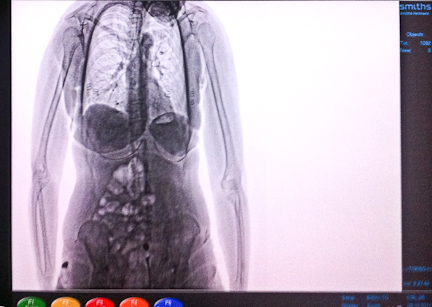
Airport Scanners – Nude and Radioactive Photographs?
As a photographer and somebody working in radiated environments (Chernobyl), the issue of airport scanners intrigues me. Are they safe? Can you really see somebody naked? Is the person in the back room secretly checking us out, or laughing at us?
Airport Scanners – Nude Men and Women
This week I managed to sneak a picture from the screens of the airport scanner in the Sao Paulo, Brazil–similar to many models in the USA. After reading various articles in the media, and seeing online examples of scans, I was expecting to, at the very least, see somebody nude. Depending on who is in front of me in the airport security line, this could be either a very interesting, or a very scary picture. I am posting precisely what I saw of the woman in front of me at the end of this blog so you can see what the airport security people really see. You can then decide for yourself it they see more of you than you want to show.
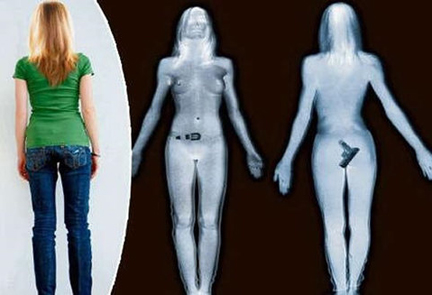
The first reputed image from a scanner that I saw online was that of a shapely blonde. It provides enough detail so that the imagination can easily fill in the details of her body. If those pictures are real, then the guys and gals in the screening room could be forgiven for staring at their screens a little longer. The second image I analyzed was one provided by the TSA (Transportation and Security Administration).
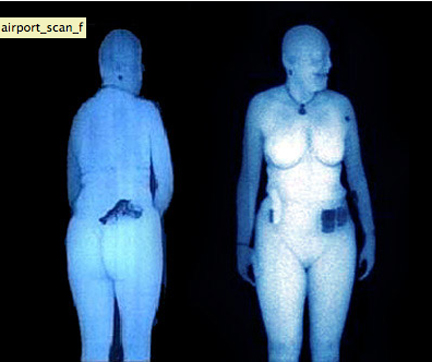
Airport Scanners – X-Ray Hoaxes
Some internet sites even claim that if you invert the images from positive to negative in Photoshop or CS (press Ctrl+ I) you get an accurate picture of what the person looks like in real life. I tested this on my computer. First I took screen shots of the images (above) and then inverted them in CS5. The result I got was indeed very life like.
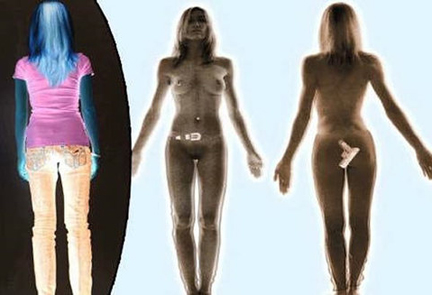
But wait. Let’s play a game of spot the differences. The first image (the one with the blonde) begins with her hands at her waist, then slightly out, in a diva like pose. This is the first clue this picture is a set-up. Secondly, her navel, nipples, and hair are all evident. Hair. Hair. Hair. I have never seen an X-ray that showed such meticulous renditions of coiffure, much less one that would tell me the color of the person’s hair. It’s too good to be true. The clincher is that I could not find this image attributable to any official source. My verdict: the image is regular digital picture that was then manipulated on a computer to appear like a airport scanner’s image. When that image is then inverted, the results, unsurprisingly look very realistic.
And the TSA image? When inverted, it also looks very realistic. But…the details are not so evident (no nipples or hair). If it looks more real, it is only because it transforms from a blue tint to a color more closely associated with skin tones. It’s an optical induction that makes us think it is more like a real photograph.
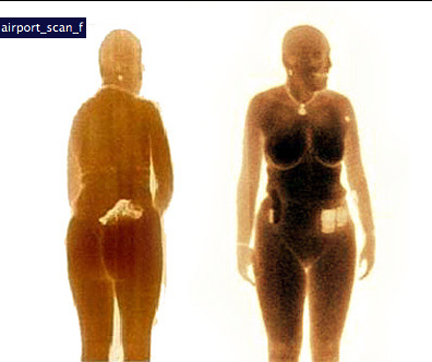
The image of the portly woman is an accurate example of what the first 250 scanners used in US airports show. It is also an accurate example of the shape of the person most likely to be in front of you in the security line. These images are produced by using AIT (Advanced Imaging Technology), which emits X-rays. The scans are very accurate and honest. There is no way to hide a gun, or a muffin top. Next time, I will ask the TSA for a copy of my scan so I can use it as part of my body transformation motivation exercise regime.
Airport Scanners – New Millimeter Wave Technology
The second batch of 250 scanners issued in the US airports relies on millimeter-wave technology produced by L-3 Communications. These machines do not use radioactive X-rays but are even more accurate in portraying the body and finding concealed weapons. The TSA, responding to privacy concerns placed a digital filter over these images known as “backscatter technology”. If you are standing in the security line and listen to the CEO of TSA speak on the monitors, he calls this “making the pictures fuzzy”.
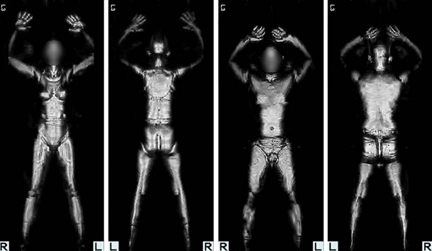
Indeed, the modified scans show less detail, but you look like Homer Simpson, which is perhaps even more of a concern to some people. The scans still show enough contour detail to justify swapping the shoe ads on the bottom of the security checkpoint bins, for penis enlargement propaganda. This would bring targeted marketing to a completely new level and avoid all those annoying email spams.
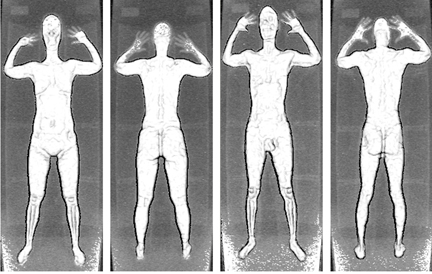
Considering mass media and propaganda are frequently telling us how our bodies should look like, it is not surprising that we don’t want anybody to see our flaws. Mirror, mirror, on the wall, who’s the fairest one of all? Apparently many Americans don’t want to know. And in true American fashion, elevated the privacy issue to the U.S. Court of Appeals for the District of Columbia Circuit.
Airport Scanners – Radioactive Fukushima and Chernobyl
All the buzz regarding matters of nudity, privacy and scanners, still leaves the issue of exposure to radiation open, at least for the AIT machines manufactured by Rapiscan Systems. Airport X-rays, however , are about as radioactive as the average banana (see chart). If the use of scanners is to be overturned, then the sale of bananas in airports should also be stopped. Conversely, if the consumption of bananas is banned, the resulting cut in calories could maybe make people loose weight, and feel better about being scanned. Then scanners could be brought back.
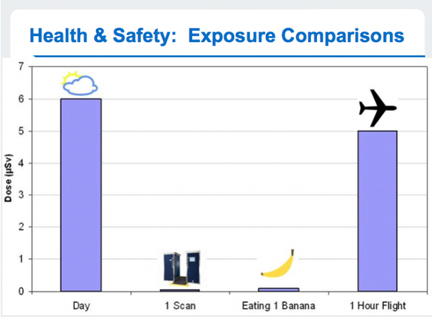
Airport Scanners – The Naked Truth
This all takes me to sharing what I saw in the Sao Paulo airport scanner screen on Monday. What I saw surprised me. The level of detail is astounding, real X-ray vision. I could see everything about the woman in front of me, right down to her tonsils. Literally.

I think those opposed to being scanned are not seeing the benefits in this type of imagery. The positive applications of scanners go beyond being honest mirrors and conduits for marketing plastic surgery. The TSA could train doctors to be the new security teams (or security teams to be doctors). Scans could be used as early warnings for tumors, vascular problems, and orthopedic diagnostics of the spine. It would reduce medical costs. All that would be left to do is to ban bananas.
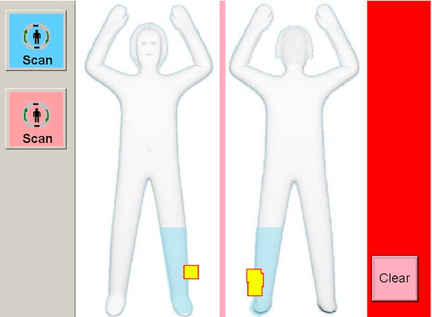

The first image is from a Transmission scanner (made by Adani / Conpass). I was unaware that these were in use at Sao Paulo. I would like to see any links you can provide of this in the Brazilian press as this is an important development. So far, these have only been used in prisons and diamond mines. I understand that Sydney airport has aquired one for some incoming flights. It is said to emit 8x the amount of radiation that a conventional backscatter scanner uses.
The second image is of course a fake. In fact the image of the woman comes from a German stock photo easily obtained on the Internet.
The third is from a backscatter x-ray scanner (Rapiscan Systems) which uses ionising radiation. Please read this before you get scanned. http://scrapthescanners.wordpress.com/2010/10/30/rapiscan-backscatter-scanners-reflection-and-absorption/
The Millimetre scanner has never been tested by anyone for possible health effects in spite of warnings from several scientists working in radiology.
The stick figure, that we are told is all that some airport security is only used on L3’s scanners. Hamburg airport police recently scrapped plans to continue with this (Italian airport authorities too) because they came back with an 80% false alarm rate.
Let me know if you find any links on the Sao Paulo airport scanners. This is a very worrying development.
I have not found any links in the Brazilian press when I wrote this, but will look again, and if I find any, forward. I had not seen the scanners a couple of months ago, and only saw them last week. They are hidden under the stairs to the VIP clubs, and, for the moment, seem to hardly be used. I expect that will change. Thanks for taking the time to respond.
for me, for me, formiiiiiiiiidable….this is great. Spoof or real…hard to know…but certainly a great “scan”…hahaha